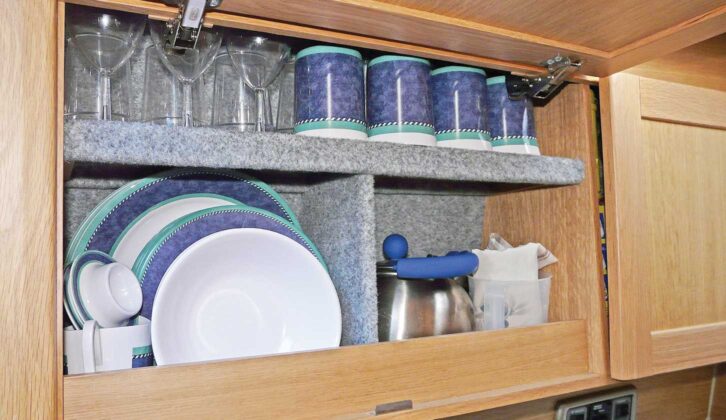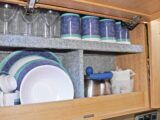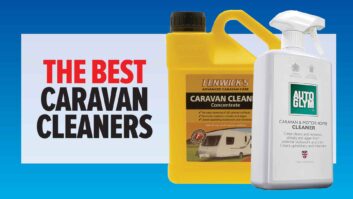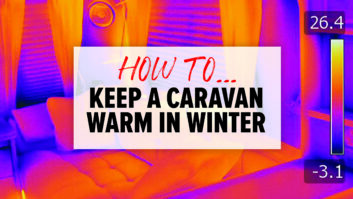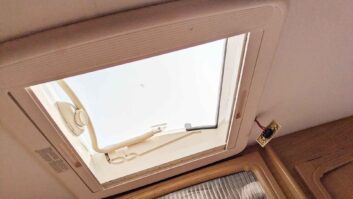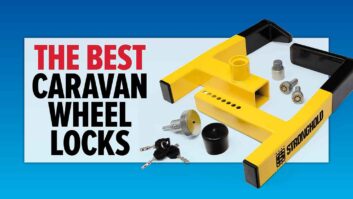When you’re choosing your new tourer, a crucial factor will be the storage space. After all, you’re going to need room to ensure you have all you need when you’re kitting out a caravan. There may be compromises along the way, but following some simple steps can help you get the most out of the available space, so you can maximise the kit you take, while ensuring you stay within the payload and making sure it’s sensibly loaded.
The most crucial aspects here are taking care when you choose the kit you’ll be taking, and then knowing how to load a caravan and tow car thoughtfully, both for when you’re on the road and when you’re pitched up.
You’re likely to have most of the equipment you’d need if this isn’t your first tourer and you’re upgrading. If you’re upsizing, chances are you will have no difficulty fitting all of your kit in, thanks to the new extra storage space. However, if you’ve opted for one of the best small caravans and have downsized, you will need to be a bit more careful when fitting everything in.
If you’re new to the world of touring, be sure to carefully plan out your list of essential caravan accessories, ready for loading. Many caravanners will leave the basic accessories in their tourer on a permanent basis, only adding perishable items and everyday clothing just before embarking on a tour.
I start by getting out my plastic storage boxes and seeing which sizes will best fit into the cupboard spaces available. These can then be allocated functions as appropriate.
Kitting out the kitchen
Choosing the best caravan crockery will be an important part of the on-tour culinary experience. A popular choice for many is the virtually indestructible melamine, although I personally like thin white glass crockery, as seen from Corelle or Oftast, the Ikea equivalent.
While heavy, you should find plates can stack quite compactly, offering a hygienic and stain-resistant base for eating.
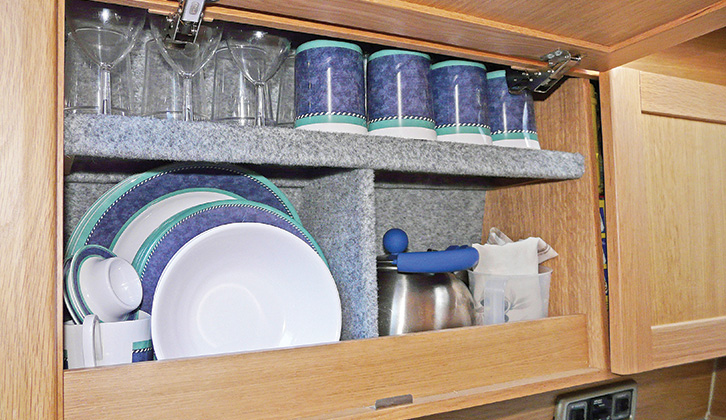
Fitting out a bespoke crockery cupboard minimises the space required and offers protection from chipping or other damage. Cutlery can be fine in a drawer, but to prevent it getting mixed up, you could use or make a tool roll to store it more securely.
A small kettle (and see our best caravan kettle guide for ideas) and toaster can be fitted into any spaces left in the kitchen unit, as can a small water-carrier for drinking water supplies, if like us, you prefer to keep the caravan system’s water for washing.
Oil, vinegar and washing-up liquids are best fitted into a small plastic container to keep them upright – you might also use this to store some 3-in-One oil, WD-40 and a small bottle of methylated spirits, which is handy as a solvent for ink stains and sticky adhesive remains.
Pitching up
Items needed for pitching include steady winders, electrical cables and connectors, an aerial cable, water-hoses and water-carriers, for both fresh and waste water. Some of these are quite bulky and heavy, and should ideally be stowed in your tow car to help distribute weight and stop them rolling around in the caravan.
I normally carry a full-length mains cable on a reel and a half-length one folded, which will often fit conveniently into the gas locker.
Storing your folding camping chairs and table while you’re on site can require much thought to ensure easy access while keeping them out of the way when they are not in use, particularly if you don’t have an awning.
Have easy access to your steps too, if you have them – and check out our best caravan steps guide if you’re looking for some.
Caravan bedding
Depending on your personal preferences – and the space you have available – your bedding might consist simply of sleeping bags or duvets, or could involve a complete domestic-style bedmaking kit.
Either way, one advantage is that items of bedding are very adaptable in shape, so storage boxes are not normally required for them.
One of my favourite space-saving hacks is to transport pillows in large or bespoke cushion covers – this way, they can be used during the day, as well as when you go to bed, without having to take up valuable storage space. The rest of the bedding you’re taking with you can be kept in underbed lockers when it’s not needed.
Packing perishable goods
Perishable items can go straight in the caravan fridge at the last minute, and we often store meat short-term in the freezer compartment – otherwise this area is sometimes underused.
Tinned food and drinks are relatively heavy and, as with all heavy items, need to be stored somewhere low down.
For convenience of access, we like to pack our tinned goods into a suitably sized plastic box. This can then be treated like a kitchen drawer, as we can reach into it as required.
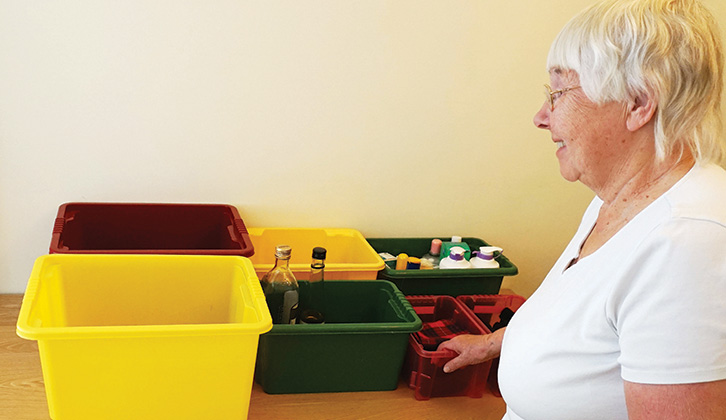
Medical items
Medical kits should not be confused with first-aid kits, which you might already have as a motoring essential.
A suitably sized box, or even a small toolbox, will be ideal to hold tablets and medicines for digestive upsets, headaches and pains, travel sickness, hayfever and so on, in addition to stocks of routine medication.
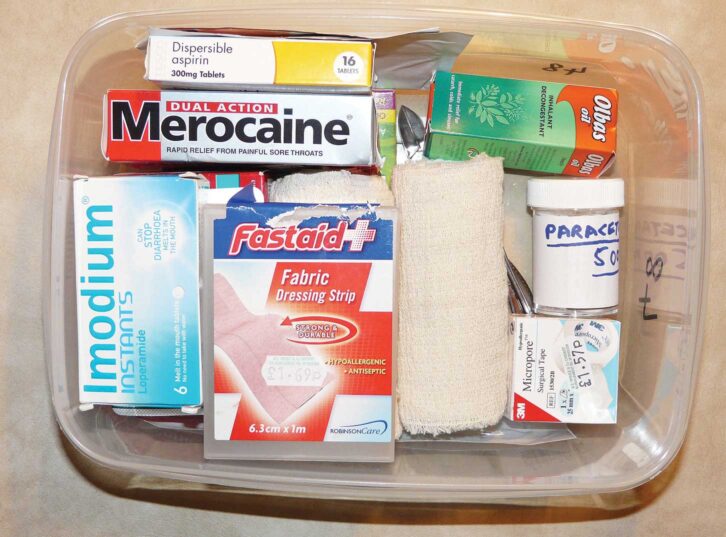
Pack some sticking plasters and elastic bandages; tweezers, nail-clippers and small scissors are also sensible additions.
You can keep this in your car if you choose, but just make sure wherever it goes, it can be reached easily if you should need it.
We’ve offered some suggestions for the top safety accessories to take on tour, if you’d like more help here.
Choosing your toolkit
The size and contents of your caravan toolkit depend on the storage space available, as well as your DIY capabilities. Like your first-aid kit, this can live in your car.
A small multimeter, sets of screwdrivers, spanners and pliers, and a small hacksaw are bound to come in handy from time to time.
Useful consumables include cable ties in various sizes, fuses and connector blocks.
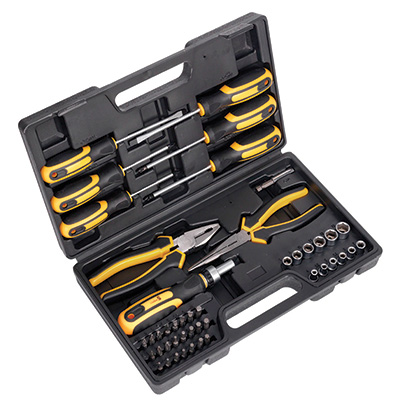
A small container of various screws, washers, and nuts and bolts, and a reel of insulating tape, would be another good idea for your toolkit.
A couple of wire coat hangers can be cut up to perform a range of emergency tasks, and I never travel without duct tape and extra-strong rubble sacks, for temporary repairs to broken windows or lost rooflights.
Towing your tourer abroad
If you drive on the Continent, you will need high-vis jackets, which must be stored where they can easily be accessed before you leave the vehicle. Your warning triangles and first-aid kit should also be stowed in an accessible spot; don’t leave them in the caravan!
Leisure accessories
Items such as cameras, laptops and binoculars require a safe place while you’re not in the caravan – you can even fit a safe into a locker if you don’t want to take them in the car with you when you go out and about.
Some paper, envelopes and stamps, stored in a thin packet, might come in handy, as will a small sewing kit for repairs.
By the time you have accommodated these items in appropriate places in your van, you will be ready to add perishable food and your clothes – then you should be all set for that exciting first trip!
For further advice on safe loading, including essential weight info, take a look at our guide to caravan weights.
Lead image: Colin Burdett
Future Publishing Limited, the publisher of Practical Caravan, provides the information in this article in good faith and makes no representation as to its completeness or accuracy. Individuals carrying out the instructions do so at their own risk and must exercise their independent judgement in determining the appropriateness of the advice to their circumstances. Individuals should take appropriate safety precautions and be aware of the risk of electrocution when dealing with electrical products. To the fullest extent permitted by law, neither Future nor its employees or agents shall have any liability in connection with the use of this information. You should check that any van warranty will not be affected before proceeding with DIY projects.
If you’ve enjoyed reading this article, why not get the latest news, reviews and features delivered direct to your door or inbox every month. Take advantage of our brilliant Practical Caravan magazine SUBSCRIBERS’ OFFER and SIGN UP TO OUR NEWSLETTER for regular weekly updates on all things caravan related.
